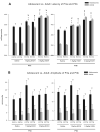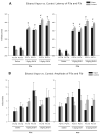Event-related potential responses to the acute and chronic effects of alcohol in adolescent and adult Wistar rats
- PMID: 24483322
- PMCID: PMC4002286
- DOI: 10.1111/acer.12299
Event-related potential responses to the acute and chronic effects of alcohol in adolescent and adult Wistar rats
Abstract
Background: This study explored the hypothesis that adolescent ethanol (EtOH) exposure may cause long-lasting changes in EtOH sensitivity by exploring the age-related effects of acute alcohol on intoxication and on event-related potential (ERP) responses to acoustic stimuli in EtOH-naïve adolescent and adult male Wistar rats and in adult rats that were exposed to chronic EtOH/control conditions during adolescence.
Methods: EtOH-naïve adolescent (postnatal day 32 [PD32]) and adult male rats (PD99) were included in the first study. In a second study, rats were exposed to 5 weeks of EtOH vapor (blood EtOH concentrations at 175 mg%) or air from PD24 to 59 and allowed to mature until PD90. In both studies, rats were implanted with cortical recording electrodes, and the effects of acute EtOH (0.0, 1.5, and 3.0 g/kg) on behavioral and ERP responses were assessed.
Results: Adolescents were found to have higher amplitude and longer latency P3a and P3b components at baseline as compared to adult rats, and EtOH was found to produce a robust dose-dependent increase in the latency of the P3a and P3b components of the auditory ERP recorded in cortical sites in both adolescents and adults. However, EtOH produced significantly larger delays in P3a and P3b latencies in adults as compared to adolescents. Acute EtOH administration was also found to produce a robust dose-dependent increase in the latency of the P3a and P3b components in adult animals exposed to EtOH vapor as adolescents and air exposed controls; however, larger acute EtOH-induced increases in P3a and P3b latencies were seen in controls as compared to adolescent vapor exposed rats.
Conclusions: Adolescent rats have a less intense P3 latency response to acute EtOH administration when compared to adult rats. Exposure to chronic EtOH during adolescence can cause "retention" of the adolescent phenotype of reduced P3 latency sensitivity to EtOH.
Keywords: Adolescence; Alcohol; Ethanol; Event-Related Potentials; P300; Tolerance.
Copyright © 2014 by the Research Society on Alcoholism.
Figures






Similar articles
-
Effect of Gabapentin on Sleep and Event-Related Oscillations (EROs) in Rats Exposed to Chronic Intermittent Ethanol Vapor and Protracted Withdrawal.Alcohol Clin Exp Res. 2018 Mar;42(3):624-633. doi: 10.1111/acer.13588. Epub 2018 Jan 31. Alcohol Clin Exp Res. 2018. PMID: 29286538 Free PMC article.
-
Electrophysiological effects of dizocilpine (MK-801) in adult rats exposed to ethanol during adolescence.Alcohol Clin Exp Res. 2008 Oct;32(10):1752-62. doi: 10.1111/j.1530-0277.2008.00760.x. Epub 2008 Jul 24. Alcohol Clin Exp Res. 2008. PMID: 18652596
-
Altered EEG responses to ethanol in adult rats exposed to ethanol during adolescence.Alcohol Clin Exp Res. 2002 Feb;26(2):246-54. Alcohol Clin Exp Res. 2002. PMID: 11964565
-
Adolescent ethanol exposure: does it produce long-lasting electrophysiological effects?Alcohol. 2010 Feb;44(1):27-37. doi: 10.1016/j.alcohol.2009.09.033. Alcohol. 2010. PMID: 20113872 Free PMC article. Review.
-
P3b Amplitude and Latency in Tic Disorders: A Meta-Analysis.Brain Sci. 2022 Dec 14;12(12):1712. doi: 10.3390/brainsci12121712. Brain Sci. 2022. PMID: 36552171 Free PMC article. Review.
Cited by
-
Effect of Gabapentin on Sleep and Event-Related Oscillations (EROs) in Rats Exposed to Chronic Intermittent Ethanol Vapor and Protracted Withdrawal.Alcohol Clin Exp Res. 2018 Mar;42(3):624-633. doi: 10.1111/acer.13588. Epub 2018 Jan 31. Alcohol Clin Exp Res. 2018. PMID: 29286538 Free PMC article.
-
Adolescent Alcohol Exposure Persistently Impacts Adult Neurobiology and Behavior.Pharmacol Rev. 2016 Oct;68(4):1074-1109. doi: 10.1124/pr.115.012138. Pharmacol Rev. 2016. PMID: 27677720 Free PMC article. Review.
-
Effects of daridorexant on rest/wake activity patterns and drinking in adult rats exposed to chronic ethanol vapor in adolescence.Alcohol. 2025 May;124:35-46. doi: 10.1016/j.alcohol.2025.01.006. Epub 2025 Jan 25. Alcohol. 2025. PMID: 39870333
-
Effects of adolescent alcohol consumption on the brain and behaviour.Nat Rev Neurosci. 2018 Apr;19(4):197-214. doi: 10.1038/nrn.2018.10. Epub 2018 Feb 15. Nat Rev Neurosci. 2018. PMID: 29467469 Review.
-
Alcohol drinking during adolescence increases consumptive responses to alcohol in adulthood in Wistar rats.Alcohol. 2017 Mar;59:43-51. doi: 10.1016/j.alcohol.2016.12.002. Epub 2017 Feb 7. Alcohol. 2017. PMID: 28187948 Free PMC article.
References
-
- Alfonso-Loeches S, Guerri C. Molecular and behavioral aspects of the actions of alcohol on the adult and developing brain. Crit Rev Clin Lab Sci. 2011;48:19–47. - PubMed
-
- Crews FT, Rudolph JG, Chandler LJ. Glutamate and alcohol-induced neurotoxicity. In: Herman BH, Frankenheim J, Litten RZ, Sheridan PH, Weight FF, Zukin SR, editors. Glutamate and addiction. Humana Press; Totowa, N.J.: 2002. pp. 357–374.
Publication types
MeSH terms
Substances
Grants and funding
LinkOut - more resources
Full Text Sources
Other Literature Sources
Medical
Miscellaneous

